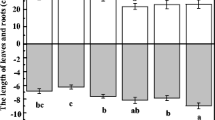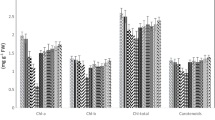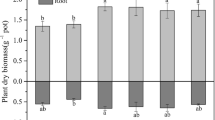Abstract
Tea saponin (TS), a kind of green biosurfactant produced by plants, was added into the Cd–pyrene co-contaminated soils to evaluate its influence on phytoremediation of Cd and pyrene by Lolium multiflorum. The results showed that the accumulation of pyrene in L. multiflorum was significantly promoted by the TS. Compared with no TS treatments (PL and ML), the aboveground concentrations of pyrene in TS treatments (PLT and MLT) increased by 135 and 30%, respectively, and the underground concentrations of pyrene in TS treatments (PLT and MLT) increased by 40 and 25%. The concentrations of Cd in the aboveground and underground parts in single contaminated treatments were all significantly more than those in co-contaminated treatments, while the situation of pyrene was quite the reverse. Besides, the addition of TS enhanced activities of dehydrogenase and polyphenol oxidase in soils and increased the biomass of L. multiflorum. The micromorphology of L. multiflorum was not affected by TS. The study suggests that the use of L. multiflorum with TS is an alternative technology for remediation of Cd–pyrene co-contaminated soils.






Similar content being viewed by others
References
Abbas G, Saqib M, Akhtar J, Murtaza G, Shahid M, Hussain A (2016) Relationship between rhizosphere acidification and phytoremediation in two acacia species. J Soils Sediments 16:1392–1399
Almansoory A, Hasan H, Idris M, Abdullah S, Anuar N (2015) Potential application of a biosurfactant in phytoremediation technology for treatment of gasoline-contaminated soil. Ecol Eng 84:113–120
Bisone S, Mercier G, Blais J (2013) Decontamination of metals and polycyclic aromatic hydrocarbons from slag-polluted soil. Environ Sci Technol 34:2633–2648
Blyth W, Shahsavari E, Morrison P, Ball A (2015) Biosurfactant from red ash trees enhances the bioremediation of PAH contaminated soil at a former gasworks site. J Environ Manag 162:30–36
Cay S (2016) Enhancement of cadmium uptake by Amaranthus caudatus, an ornamental plant, using tea saponin. Environ Monit Assess 188:1–8
Chen T, Liu X, Zhang X, Hou Y, Chen X, Tao K (2016a) Enhanced Scirpus triqueter phytoremediation of pyrene and lead co-contaminated soil with alkyl polyglucoside and nitrilotriacetic acid combined application. J Soils Sediment:1–7
Chen T, Liu X, Zhang X, Chen X, Tao K, Hu X (2016b) Effect of alkyl polyglucoside and nitrilotriacetic acid combined application on lead/pyrene bioavailability and dehydrogenase activity in co-contaminated soils. Chemosphere 154:515–520
Chen X, Liu X, Zhang X, Cao L, Hu X (2017) Phytoremediation effect of Scirpus triqueter noculated plant-growth-promoting bacteria (PGPB) on different fractions of pyrene and Ni in co-contaminated soils. J Hazard Mater 325:319–326
Chigbo C, Batty L (2014) Phytoremediation for co-contaminated soils of chromium and benzo[a] pyrene using Zea mays L. Environ Sci Pollut R 21:3051–3059
Colacicco A, Gioannis G, Muntoni A, Pettinao E, Polettini A, Pomi R (2010) Enhanced electrokinetic treatment of marine sediments contaminated by heavy metals and PAHs. Chemosphere 81:46–56
Gao Y, Ling W, Zhu L, Zhao B, Zheng Q (2007) Surfactant-enhanced phytoremediation of soils contaminated with hydrophobic organic contaminants: potential and assessment. Pedosphere 17:409–418
Gianfreda L, Antonietta R, Piotrowska A, Palumbo G, Colombo C (2005) Soil enzyme activities as affected by anthropogenic alterations: intensive agricultural practices and organic pollution. Sci Total Environ 341:265–279
Lalande R, Gagnon B, Simard R, Côté D (2000) Soil microbial biomass and enzyme activity following liquid hog manure application in a long-term field trial. Can J Soil Sci 80:263–269
Li W, Khan MA, Yamaguchi S, Kamiya Y (2005) Effects of heavy metals on seed germination and early seedling growth of Arabidopsis thaliana. Plant Growth Regul 46:45–50
Liao C, Liang X, Lu G, Thai T, Xu W, Dang Z (2015) Effect of surfactant amendment to PAHs-contaminated soil for phytoremediation by maize (Zea mays L.) Ecotox Environ Safe 112:1–6
Liu J (2005) Physiological and ecological responses of maize seedlings to cadmium stress. Chinese J Ecol 24:265–268
Lu M, Zhang Z, Wang J, Zhang M, Xu Y, Wu X (2014) Interaction of heavy metals and pyrene on their fates in soil and tall fescue (Festuca arundinacea). Environ Sci Technol 48:1158–1165
Mohammadi K, Heidari G, Nezhad M, Ghamari S, Sohrabi Y (2012) Contrasting soil microbial responses to fertilization and tillage systems in canola rhizosphere. Saudi J Biol Sci 19:377–383
Najeeb U, Jilani G, Ali S, Sarwar M, Xu L, Zhou W (2011) Insights into cadmium induced physiological and ultra-structural disorders in Juncus effusus L. and its remediation through exogenous citric acid. J Hazard Mater 186:565–574
Pérez R, Cabrera G, Gomez J, Abalos A, Cantero D (2010) Combined strategy for the precipitation of heavy metals and biodegradation of petroleum in industrial wastewaters. J Hazard Mater 182:896–902
Perucci P, Casucci C, Dumontet S (2000) An improved method to evaluate theo-diphenol oxidase activity of soil. Soil Biol Biochem 32:1927–1933
Rascio N, Navari-Izzo F (2011) Heavy metal hyperaccumulating plants: how and why do they do it? And what makes them so interesting. Plant Sci 180:169–181
Rezania S, Ponraj M, Talaiekhozani A, Mohamad S, Din M, Taib S, Sabbagh F, Sairan F (2015) Perspectives of phytoremediation using water hyacinth for removal of heavy metals, organic and inorganic pollutants in wastewater. J Environ Manag 163:125–133
Santos E, Abreu M, Macías F, Varennes A (2016) Chemical quality of leachates and enzymatic activities in Technosols with gossan and sulfide wastes from the São Domingos mine. J Soils Sediments 16:1366–1382
Siddiqui M, Abbasi B, Ahmad N, Ali M, Mahmood T (2012) Toxic effects of heavy metals (Cd, Cr and Pb) on seed germination and growth and dpph-scavenging activity in Brassica rapa var. turnip. Toxicol Ind Health 30:238–249
Singer A, Bell T, Heywood C, Smith J, Thompson I (2007) Phytoremediation of mixed-contaminated soil using the hyperaccumulator plant Alyssum lesbiacum: evidence of histidine as a measure of phytoextractable nickel. Environ Pollut 147:74–82
Thavamani P, Megharaj M, Naidu R (2012) Multivariate analysis of mixed contaminants (PAHs and heavy metals) at manufactured gas plant site soils. Environ Monit Assess 184:3875–3885
Wang G, Zhou Y, Wang X, Chai X, Huang L, Deng N (2010) Simultaneous removal of phenanthrene and lead from artificially contaminated soils with glycine-beta-cyclodextrin. J Hazard Mater 184:690–695
Wang M, Chen Y, Chen S, Chien S, Sunkara S (2012) Phytoremediation of pyrene contaminated soils amended with compost and planted with ryegrass and alfalfa. Chemosphere 87:217–225
Wang Q, Liu X, Wang C, Zhang X, Li H, Chen T, Hou Y, Chen X, Xu G (2015) Solubilization effect of surfactants on morphological transformation of cadmium and pyrene in co-contaminated soils. Water Air Soil Poll 226:147–156
Wang Q, Liu X, Zhang X, Hou Y, Hu X, Liang X, Chen X (2016) Influence of tea saponin on enhancing accessibility of pyrene and cadmium phytoremediated with Lolium multiflorum in co-contaminated soils. Environ Sci Pollut R 23:5705–5711
Wei J, Liu X, Wang Q, Wang C, Chen X, Li H (2014) Effect of rhizodeposition on pyrene bioaccessibility and microbial structure in pyrene and pyrene-lead polluted soil. Chemosphere 97:92–97
Xia H, Chi X, Yan Z, Cheng W (2009) Enhancing plant uptake of polychlorinated biphenyls and cadmium using tea saponin. Bioresour Technol 100:4649–4653
Zhang S, Zhao S, Gu J (2004) Impact of soil diesel oil pollution on seed germination of alfalfa. Environ Sci Technol 27:88–89
Zhang Z, Su S, Luo Y, Lu M (2009) Improvement of natural microbial remediation of petroleum-polluted soil using graminaceous plants. Water Sci Technol 59:1025–1035
Zhang Z, Rengel Z, Chang H, Kathy M, Ljiljana P, Radmila T (2012a) Phytoremediation potential of Juncus subsecundus in soils contaminated with cadmium and polynuclear aromatic hydrocarbons (PAHs). Geoderma 175:1–8
Zhang X, Han Y, Bao G, Ling T, Zhang L, Gao L, Xia T (2012b) A new saponin from tea seed pomace (Camellia oleifera Abel) and its protective effect on PC12 cells. Molecules 17:11721–11728
Acknowledgments
This work was funded by the National Natural Science Foundation of China (Nos. 21677093, 41373097) and Key Laboratory of Water Environment and Marine Biological Resources Protection of Zhejiang Province (No. KF201503).
Author information
Authors and Affiliations
Corresponding author
Ethics declarations
Conflict of interest
The authors declare that they have no conflict of interest.
Additional information
Responsible editor: Elena Maestri
Rights and permissions
About this article
Cite this article
Liu, X., Cao, L., Wang, Q. et al. Effect of tea saponin on phytoremediation of Cd and pyrene in contaminated soils by Lolium multiflorum . Environ Sci Pollut Res 24, 18946–18952 (2017). https://doi.org/10.1007/s11356-017-9515-2
Received:
Accepted:
Published:
Issue Date:
DOI: https://doi.org/10.1007/s11356-017-9515-2




